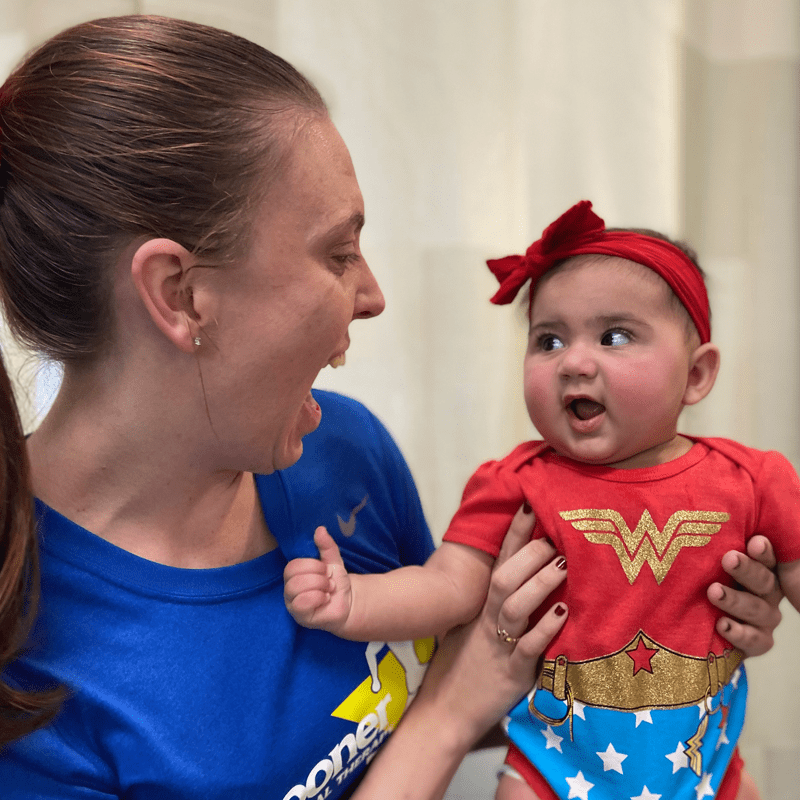Being a parent comes with all sorts of surprises—some exciting, some daunting, and some just plain scary. Along with your supportive team of family members, friends, doctors, clergy members and others, pediatric physical therapists are here to help you navigate some of parenting’s crazy curve balls.
One condition we treat a lot of infants for in our clinics is called torticollis, and while the name alone sounds alarming, you should know that it’s perfectly treatable. We talked with Amanda DeWitt, PT, DPT, who specializes in pediatric physical therapy, to answer some typical questions she hears from parents, and to get her perspective on how parents can best approach treatment for this common condition.
What Is Torticollis and What Causes It?
Torticollis is a condition generally seen in infants in which the child’s head is involuntarily and persistently turned or twisted to one side. “Torticollis can be caused in utero because of the baby’s positioning, and it can also be caused after birth because they don’t have the head strength to maintain their head upright, so the neck muscles become tightened or thickened and restricted,” Amanda explains.
How Is Torticollis Diagnosed?
While it can be hard to detect in very young infants, there are some telltale signs: “Sometimes parents will notice their child holding their head in the same direction or notice that the head is always rotated,” she says. Another thing to watch for is if your baby favors turning her head to the same side every time she sleeps, or if she prefers one breast or feeding position. Torticollis can become even more apparent once babies develop head and neck control.
Often, it’s diligent parents who bring these observations to a pediatrician, but pediatricians are on the lookout for torticollis, as well.
Can Torticollis Be Treated?
It absolutely can be treated, Amanda says. Your pediatrician may recommend turning your baby’s head to the other side while they are sleeping, or trying a specific massage technique, but it’s most likely that he or she will refer you to physical therapy.
“The earlier that they get into PT, the better the outcome,” Amanda says. “As the child develops, we want to make sure that the muscle is being lengthened through different stretching techniques, as well as strengthening and working on head and neck control to correct muscle imbalances: one side will be tight and contracted, while the other side will be weak because they haven’t been able to utilize that range of motion.”
The ideal age for treatment is typically between one to six months. “It’s important to get them into PT as soon as possible, because their heads are still so malleable at this point. The bones start to harden as they get closer to one year of age,” making the condition more difficult to treat.
Can There Be Developmental Problems Or Lasting Damage?
Some children with torticollis may struggle reaching certain milestones if not treated early enough. Amanda explains that, because the skull bones of infants are soft and still developing, the heads of those with torticollis are at risk for becoming misshapen. Since infants must be put to sleep on their backs, their heads can become flattened on one side and protruded on the opposite side.
“If one side of the head is misshapen, that can start to affect milestones because the child can have difficulties rolling that direction. Or, for instance, due to the way our bodies just naturally develop, you’re going to roll the direction you’re looking,” Amanda explains. “When they are sitting, it can affect their balance, because they are leaning toward one direction, and it can affect their ability to sit independently.”
If torticollis is left untreated, kids can develop pronounced facial asymmetries or even have trouble wearing bike or other sports helmets.
How Can Physical Therapy Correct Torticollis?
Physical therapy will involve two interdependent parts: One is in-clinic sessions with hands-on therapy to stretch, strengthen and facilitate milestones. Two is a heavy emphasis on education for you as the parent, teaching you how to stretch, reposition and help your little one progress toward milestones at home—without worrying about hurting her.
“There’s a good chance a kid will be fussy and resistant, but it’s important for parents to know they aren’t hurting their child. They’re not damaging anything,” Amanda says. Therapy usually takes a couple of months, depending on how severe a particular case of torticollis is. Being consistent in doing the at-home exercises makes a big difference in treatment time, as well.
Then, before you know it, your baby’s neck muscles will be retrained and she will be trying to crawl, successfully holding up her own head against gravity, and ready to conquer her own little world.
Learn more about Pediatric Physical Therapy at Spooner Physical Therapy. Ready to schedule an appointment? Schedule an appointment or complimentary movement screen with a Spooner physical therapist at one of our locations throughout the valley.

